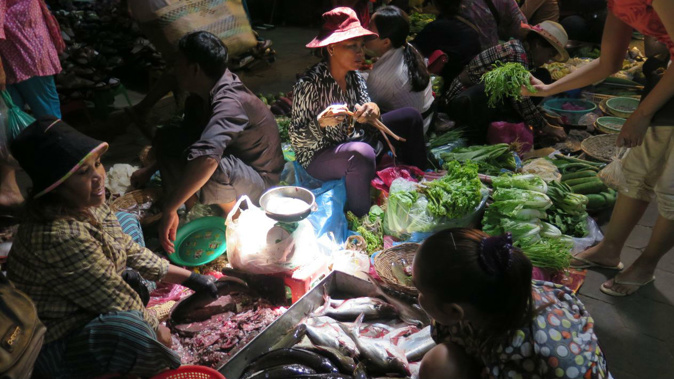
It wasn’t that long ago that Siem Reap, the gateway to the Angkor temple complex, was just a quiet, dusty town of rutted roads and dark nights. But the past fifty years has transformed the city into a charismatic destination, full of paradoxes, as ancient traditions and modern bling rub shoulders to form a glittery tourist mecca. Many hit-and-run tourists will sweep through Siem Reap to tick off the temples of Angkor, without getting a flavour of the city. With a population on par with Hamilton’s, there’s a heady, alluring buzz about the place that I found instantly seductive.
And if clambering over and around Angkor’s mighty sandstone structures soon tuckers you out, mix and match your temple-touring with the antidote of slowly soaking up the sights in this compact city. In the heart of town, the Old Market is a head-swirl of colour, character and the bizarre. Souvenir stalls litter the edges of the market, touting trinkets of dubious quality, but venture inside the rabbit warren of endless aisles to savour a slice of local life, where vendors flog off everything imaginable from pots and pans to parasols.
But it’s the food section, a heaving emporium of fresh produce in a rainbow of colours, in addition to the startling variety of meats and seafood, that provides the biggest sensory assault. Head here early in the morning, when the hotel chefs and locals are out in force to bag the best market bounty. It’s not a place to be squeamish as you wander by dozens of headless chooks, legs tightly bound and festooned in flies, or wonder what an earth that blood and gore soaked speciality, selling like hot cakes, might actually be. It turns out one of the biggest sellers at the Old Market, which I could not bring myself to try, is duck foetus. It looks as graphically horrific as it sounds.
Siem Reap boasts a stack of markets – the Old Market being the most traditional and the Night Market remaining a perennial hit with visitors. Take in some of the local entertainment, like the Landmine Victim Band which serenades shoppers at the market entrance, with traditional Khmer music. If you’ve been busy ticking off the temples, your feet will certainly feel it, which probably explains why Siem Reap is flush with touts offering foot massages. You can take it a step further with a fish pedicure, by braving the waters of Dr. Fish. The original is located in the Angkor Night Market, but imitators have morphed all over town.
I’ve never had a foot fetish – in fact I hate having my feet played with, let alone having them nibbled by cleaner fish. However, if you’re happy to have your toes tickled and nibbled in a fish tank, it’s a sure-fire way to send all that dead skin packing. And it will only cost you about $NZ5. If you want to give it a crack, a word of advice. Be first in line at Dr. Fish, because by the end of the trading day, the water in the tank will be decidedly soiled, after having played host to dozens and dozens of feet and dead skin flakes. Plus, the fish will be sure to heartily nibble your skin, at start-up, because they’ll be hungry!
The beating heart of Siem Reap’s nightlife is undoubtedly Pub Street, off Sivatha Boulevard. By day, this shamelessly named lane looks quite sedate, but after dark, it morphs into a fleshy, frothy scene reminiscent of Phuket. Closed to traffic at night, it’s the sort of place where you dive in, party hard and crawl out. By day and night, street stalls bustle with a head-spinning selection of cheap eats, ranging from the familiar to the seriously intrepid. Daring to walk on the wild side, I sampled a deep fried tarantula, washed down with sugarcane juice – but could only stomach one leg.
Roasted insects are a very big business in Siem Reap and alongside the various offerings at the street stalls, check out Bug’s Café, Cambodia’s famous insect tapas restaurant. The menu lustily spans the insect kingdom, featuring crickets, scorpions, grasshoppers, ants, bees, silkworms ...you name it. An unparalleled taste of adventure – packed with protein.
Moving beyond the critters, Cambodian cuisine is really starting to make its mark. I noticed a Cambodian restaurant recently opened in Christchurch, even though the nation’s cuisine has traditionally been overshadowed by its neighbours, Thailand and Vietnam. But Siem Reap has clearly emerged as a dining destination in recent years, with strong and vibrant flavours which draw inspiration from China and India – stir-frying and dried spices.
A signature national dish is fish amok – steamed and curried fish coated in kroeung paste and cooked in a cup made from banana leaves. The other must try signature is beef lok lak, made with diced beef and garnished with citrus and pepper dip. Chic and contemporary, a great place to sample Khmer cuisine is the Chanrey Tree, which has cultivated a global following for its fine-dining experience. Alongside the signature dishes, I also savoured their rispy sticky rice with Natang Sauce and Spring Rolls. Aaah, heaven. David Beckham dined here last year and raved about it – so it’s got to be good, right?
I’m always intrigued to discover ex-pat Kiwis plying their trade in far-flung places, and in Siem Reap, head to Jungle Burger in Street 26, for a taste of home. This unabashed sports bar and bistro is draped in New Zealand and All Blacks flags. It’s run by a former Christchurch lad, Clayton Venis, who opened it up five years ago. Ask the locals and they’ll swear it makes the biggest drool-inducing burgers in town.
Finally, in a city flush with entertainment options, don’t miss Siem Reap’s answer to Cirque du Soleil. Phare is a traditional Cambodian Circus – animals not included – that opened its big top for nightly shows three years ago, due to its surging popularity. Several generations of circus performers who graduated from Phare’s training campus have gone on to perform all over the world, including with Cirque du Soleil.
With an emphasis on heart-in-your-mouth performance art, the acrobatics, contortions and juggling skills are breath-taking and are beautifully woven into a wider narrative about the Cambodian story. Like so many other aspects to Siem Reap, Phare is a not-for-profit, with all proceeds reinvested into building better lives for the performers and their families – many who have endured extreme abuse and hardship, and now thriving in the world of entertainment against all odds.
Mike Yardley is Newstalk ZB’s Travel Correspondent on Saturday Mornings with Jack Tame.
Take your Radio, Podcasts and Music with you









